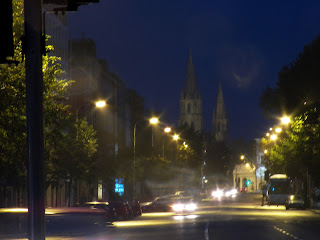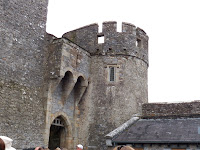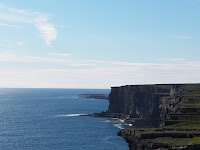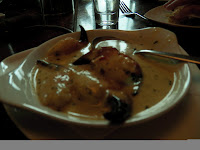I have been using a new web format for class! Check out some of my articles and pictures! Click here or copy the web address: http://kristietravelwriting.weebly.com/
On another note, I took a night photography class! These are some of my favorites.
Green Summer
Wednesday, August 8, 2012
Tuesday, August 7, 2012
Don't Expect All the Answers
Irish people I
have met can be disdainful and bemused; sharp-witted yet reflective; tight-lipped
and open-faced. When you walk into a place of business, you know this is not
the American South where everyone is greeted with a smile. Initially, it made
me nervous.
I crept into the
office, feeling every bit a foreigner. I was there to report a malfunction in
my bathroom. The hot water was stuck at 48 degrees Celsius, and after jumping
out of the steaming water, I later found that was about 118 Fahrenheit.
The receptionist
glanced in my direction briefly and coolly, perhaps hoping that I would go away
and not give him anything to worry about. His skin was pale, which is not
surprising considering the Irish sun generally shines in only one out of ten
days. His head was dark, though, matching his eyes that miraculously enough
looked very interested in being bored.
When I told him
of my dilemma, he tucked in his lifted chin, and, lowering his head, inquired,
“stuck at farty-eht, is it?” His severity was betrayed by a chuckle at my
plight. He didn’t look down his nose at me, aloof or even annoyed, as I had
feared. He didn’t even look through me, reducing me to my problem. His gaze was
straight-on, steadfast, eye-level.
It had been several
days before someone could make it out to fix my shower. I had to survive on
splashing the scalding water onto myself from a slight distance. But one
afternoon, I walked into my room to find another Irish lad with plumbing tools
laid out on my carpet. He was earnest, and like his fellow employee, tucked in
his chin to level his gaze. He was even paler than the receptionist. Although
young, his skin and hair looked like gray mist. His workman’s denim also
appeared grayed by his presence.
“It’s the whole
ting’ll have to be replaced. ‘Tis too old and no good now,” he muttered, his
low voice and thick accent barely audible. “I’ll be back after lunch to finish
up.” Lunch took about two and a half hours, but the young plumber did indeed
return. The next day he finished the work, but left sincerely apologizing for
the ceramic dust on the ground, despite my attempt to reassure him it was not a
problem to me. He called the housekeeper up to vacuum, or “hoover” the carpet.
Back home, the
American counterparts of these men would probably tilt back their sun-bleached
heads, turn their eyes upward looking to the sky, or perhaps try to gaze into
their own minds for a self-sufficient solution. But not these Irish lads; the
eyes level and take a clear firm look at you. It’s like they were intent on
understanding the question more than on giving an answer.
If you look
through travel blogs and articles, you can surely find some commentary on how
Europeans don’t feel a need to smile at someone they don’t know. This elicits
mixed results from American travellers. On one hand, it could make the
unaccustomed feel uncomfortable, but on the other hand, the Europeans feel they
are just being more genuine. A store clerk in Texas may give a big bright
smile, but perhaps it is simply the height of insincerity. Americans, for the
most part I hope, are trying to be welcoming and warm, but can they really
always mean it? A grinning American myself, I admit I was one who initially
felt extremely uncomfortable, wondering if I had done something to offend the
scowling clerk.
I had a moment
of breakthrough though. Since I have been in Ireland, I have frequently gotten
coffee from a café in the mornings; the café fully equipped with a stone-faced
barista. The other day though, as I walked in, though, she smiled and said
“Hiya!” I was mildly astonished. She recognized me and didn’t even ask if I
wanted cream (she knew I did). Knowing that her reaction was genuine and based
on an actual personal connection was priceless. Her smile was personal, not
mechanical; I basked in the sincerity.
As an American, I
don’t know if I will (or can) stop smiling when I meet someone, but I have come
to appreciate the deeper sense of connection needed for a real smile, and
indeed the depth of feeling that be conveyed with a passive face. The store
clerks may not be gregarious, but that doesn’t mean they don’t care about their
jobs or the people they interact with. As I began to soak into a new culture of
interpersonal relations, my nervousness began to fade like morning mist.
Wednesday, July 25, 2012
Cashel, Cahir, and Ormond Castles
This Wednesday, my study abroad group went on an excursion to class.... Back in time!! We took a tour of some of Ireland's most famous castles, some of them dating back to the 1000 and 1100s!
The first stop was The Rock of Cashel. This impressive structure has its origins in the 1000s as the seat of the king of Munster (South Ireland today). He was a powerful king, and was converted to Christianity by St. Patrick. Legend has it that as Patrick was performing the baptismal ceremony, he set his staff down so hard, it pierced the king's foot, but he didn't say a word. When Patrick realized what happened, he asked the king why he didn't complain. He thought it was part of the process!
Just down the hill from Cashel is Hore Abbey. Yes, just like it sounds. While today it makes the place sound like a brothel, "hore" is actually the word for gray. The abbey was named for the gray cloaks worn by the monks.
The abbey was actually burned to the ground because one king had a dream that the monks tried to murder him... senseless? Well, the monks found a new home and never killed him...
The next stop was Cahir Castle, historically owned by the Butler family, named for their position as chief butlers to the English monarchy. We took a tour focusing on all the ways we, had we been attacking soldiers, could have been killed. This place was invincible before the days of explosives! Full of slits for archers and gaps for pouring hot lime and boiling fat on intruders, I think the most "inventive" defense was to sling dead bloated animals onto the attacking forces. The gasses in the animal made its rotting guts explode all over the now very demoralized and probably infected soldiers.
The castle does, however, bear a mark of more modern warfare... a cannon ball has been lodged in the wall for the past 400 years. At the bottom of the castle is the oubliette, or dungeon. Named for the French word "oublier," "to forget," this is where they locked away prisoners. It was dark and damp and very dungeon-y. On another note, this castle was used in the filming of Braveheart! When Mel Gibson first arrived, they didn't recognize him and made him pay for a tour.
The final stop was Ormond Castle and Manor House. Also owned by the Butler family in Elizabethan (late 1500s) times, this place was a mash-up of a Norman (1100s) and Elizabethan structure. The Norman structure was in ruins, but was impressive nonetheless. We toured inside of the restored manor house, but no pictures were allowed. It was partially furnished with pieces from the time, and we were able to see the original plasterwork and walk the maze of rooms from ground floor to attic.
America doesn't have castles and structures 1000 years old, so compared with the newness and future-forward America, it was surreal to walk along these places which have amazed people for a millennium and think of an entirely foreign people, separated from us by the walls of time, leaving us only ruins of their ingenuity.
The first stop was The Rock of Cashel. This impressive structure has its origins in the 1000s as the seat of the king of Munster (South Ireland today). He was a powerful king, and was converted to Christianity by St. Patrick. Legend has it that as Patrick was performing the baptismal ceremony, he set his staff down so hard, it pierced the king's foot, but he didn't say a word. When Patrick realized what happened, he asked the king why he didn't complain. He thought it was part of the process!
Later in about the 1200s, ancestors of the king donated the castle to the Church where it was converted to also contain a magnificent cathedral. It was the seat of the bishop of Munster until the 1700s. The place is also called St. Patrick's rock for its association to the man who brought Christianity to Ireland.
Just down the hill from Cashel is Hore Abbey. Yes, just like it sounds. While today it makes the place sound like a brothel, "hore" is actually the word for gray. The abbey was named for the gray cloaks worn by the monks.
The abbey was actually burned to the ground because one king had a dream that the monks tried to murder him... senseless? Well, the monks found a new home and never killed him...
The next stop was Cahir Castle, historically owned by the Butler family, named for their position as chief butlers to the English monarchy. We took a tour focusing on all the ways we, had we been attacking soldiers, could have been killed. This place was invincible before the days of explosives! Full of slits for archers and gaps for pouring hot lime and boiling fat on intruders, I think the most "inventive" defense was to sling dead bloated animals onto the attacking forces. The gasses in the animal made its rotting guts explode all over the now very demoralized and probably infected soldiers.
The castle does, however, bear a mark of more modern warfare... a cannon ball has been lodged in the wall for the past 400 years. At the bottom of the castle is the oubliette, or dungeon. Named for the French word "oublier," "to forget," this is where they locked away prisoners. It was dark and damp and very dungeon-y. On another note, this castle was used in the filming of Braveheart! When Mel Gibson first arrived, they didn't recognize him and made him pay for a tour.
The final stop was Ormond Castle and Manor House. Also owned by the Butler family in Elizabethan (late 1500s) times, this place was a mash-up of a Norman (1100s) and Elizabethan structure. The Norman structure was in ruins, but was impressive nonetheless. We toured inside of the restored manor house, but no pictures were allowed. It was partially furnished with pieces from the time, and we were able to see the original plasterwork and walk the maze of rooms from ground floor to attic.
America doesn't have castles and structures 1000 years old, so compared with the newness and future-forward America, it was surreal to walk along these places which have amazed people for a millennium and think of an entirely foreign people, separated from us by the walls of time, leaving us only ruins of their ingenuity.
Monday, July 23, 2012
Aran Islands
I woke up at 4:30 am Friday morning. I was catching the earliest bus to Galway with a group of friends. From Galway, we were going to Rosaveal where we would catch a Ferry to the Aran Islands. The farthest western point of Ireland, the Aran Islands is one of the last places where the people primarily speak Irish Gaelic, and was the setting for one of the books we have been reading for class.
It was a long journey (about 5 hours total) but it was worth every minute. As our ferry landed and we walked down the pier, we were instantly greeted by islanders wanting to offer us bike, buses, and horse carriage rides. We intended to bike upon our professor's recommendation, and we were soon accommodated. Little did we count on the five mile ride over hills and down winding roads! The buses and horses we declined seemed to be whizzing by as we rode.
Aside from moments of near-death (probably not really), the ride was gorgeous. Riding along the coast, we winded along the bays and rocky seashores, pummeled by the Atlantic Ocean. Small white houses, almost consolidated into a village peered from around hillsides while grazing cows and numerous goats placidly watched us go by. It was desolate in a way, but sublimely lovely.
We stayed the night at the B and B of a warm Irish lady who welcomed us with tea and scones; the name was Kilkenny House, I believe. The main attraction of our trip, though, was yet to come.
Dun Aengus is an ancient military fort dating back to the Stone Age. Jutting rocks pose a fearsome threat to potential invaders as does the increasingly death defying drop off a cliff to either side of the fort. 500 feet in the air, I crawled to edge to peer down at the foaming waves below. I was a speck on the rocky face of the cliff.
Entering the fort itself, the space was perhaps the size of a football field, filled with rocks smoothed by time and covered with grass. There was something like a stage which was perhaps used in ancient rituals; that day, I climbed up and lay beside the edge of cliff. It was otherworldly.
The sun was just beginning to set, casting dancing light over the serene Atlantic. Clouds in the sky heaved and subsided, dissipating into endless blue. I just lay by the cliff's edge for a while, soaking in this ancient and devastating beauty.
As the sun threatened to set on us, we set out for our abode that night. A couple of us stopped by one of the beaches to splash in the frigid and very clearly northern ocean. The sand was soft, and there were several jellyfish dotting the sand. I touched one and picked it up. It really felt like jelly!
The next morning we biked over the deserted roads to return the bikes and stop in the tourist shops before the ferry came back to take us away. There was another long travel ahead, and we would stop again in Galway in the midst of an arts festival, but the haunting images of Aran would not leave us so quickly.
Friday, July 13, 2012
Kinsale
Kinsale lies along the southern coast of Ireland, about a half-hour's drive or a hour long bus ride from Cork City. Kinsale was my destination today. It is Friday the 13th, and this day marks the first full week I have been in Ireland, and it is also the day in which I most enjoyed Irish cuisine.
I left with a group of four at 9:30am this morning and hailed a taxi to take us to the bus station. "Where are you from?" he asked us. After learning we were from Texas, he became interested in our bovine holdings. "Any ranches have you?" (next time you sterotype the Irish, just remember how many we have as Texans. Don't you Always walk around your ranch in cowboy boots?)
One member of our group happened to have parents who owned 50 head of cattle. "Fifty!?" he asked with disbelief, "Five-oh?" Yes indeed! "Well now, dat twould be considered a smahll farm here!" The ranch was really kind of a hobby. "Most fahrmers have at least five hundred." I have no doubts after seeing the Irish countryside.
We traveled to Kinsale on Bus Eireann, the national bus service. I don't think I can ever get used to driving through Ireland. The swells of the greenest hills, spattered with contented grazing cows and sheep. Tucked into the folds of the land lie the most picturesque farmhouses, and even more stunning, ancient castles, forts, and cathedrals rise up as reminders of past grandeur.
We arrived in Kinsale and after taking photos of the sailboats, we happened upon a delightful homemade chocolate shop. The twinkling owner offered us samples of sea salted dark chocolate and made recommendations for the peppermint creams he had just finished making. We sampled and purchased, enchanted and tastefully delighted by his wares.
The little town is exactly what I picutured as an "Irish harbor town." The hills which have built up sigh as they slip down the mouth of the River Lee and into the Atlantic, ushering sailboats and fishing rigs into these waters of plenty.
The houses were in the style they have been in since the Titantic, though many of the store cater very much to tourists who like to shop and eat. We wandered down the winding and wonderfully disorienting streets until we came to the Lemon Leaf Cafe, offering a Full Irish Breakfast. We were hooked.
Complete with a pot of tea, breakfast in this tiny cafe consisted of fried eggs, sausage, black and white pudding, bacon, toast, and a tomato. This may not sound hugely exotic, but oh my, the taste of it! The bacon was my favorite. Looking nothing like U.S. bacon, it was not crispy, but thick and juicy. The toast was probably baked that morning and was covered with butter that was more like cream than solid and had so much flavor, you could tell that the cow enjoyed her life and had some quality grass. From what I have seen, there just isn't the kind of mass-produced preservative-laden food culture which dominates the U.S. Especially with the dairy products, the farms don't just grow, but cultivate a culinary experience in something as simple as butter.
After breakfast, we continued to explore the shops with low-ceilings, complicated infrastructure, and a smell of a hundred years of life in the rain. The wares ranged from kitschy shamrock keychains to lamb wool sweaters. I managed to hold off on souvenir shopping for now, but it was hard here!
We stopped for a snack about mid-afternoon at a diner inspired by the U.S. 1950s where I had a milkshake. The no preservative, fresh made chocolate-hazel-nut ice cream mixed with fresh whole milk (simply mixed!) was amazing. One of our last stops of the day was Kinsale Silver Shop. Silver pendants, rings, and token adorned the crevices in the walls. In the corner the silversmith was hard at work, polishing yet another piece. He has been crafting for twenty years, he told us, "a long time, sometimes."
We finished the day at Kinsale at a restaurant called Fishy Fishy which came highly recommended by our professors. I shared a savory dish of crab claws in garlic-lemon-chili sauce. It was delicious. As it was not American snow crab, we decided it must be "harbor crab," caught that day just outside our window.
Subscribe to:
Comments (Atom)


















































